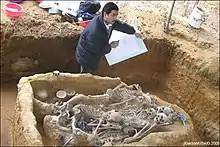Génocide guatémaltèque
Le génocide guatémaltèque, ou parfois appelé génocide maya[1] ou holocauste silencieux[2] (en espagnol Genocidio guatemalteco, Genocidio maya, Holocausto silencioso) est l'ensemble constitué du massacre, de la disparition forcée, de la torture et de l'exécution sommaire de civils mayas lors d'opérations de contre-insurrection menées par des militaires du Guatemala[3] - [4] - [5] - [6]. Les événements ont été rapportés notamment par Human Rights Watch[7].

La répression atteint un niveau génocidaire dans les provinces du nord, où l'Armée de guérilla des pauvres (EGP) est présente. Les militaires auraient ainsi participé à 626 massacres[8], l'armée reconnaissant la destruction de 440 villages mayas entre 1981 et 1983, durant l'apogée des événements. Une étude de la Juvenile Division of the Supreme Court de mars 1985 révèle que plus de 200 000 enfants ont perdu au moins un parent. On estime entre 45 000 et 60 000 victimes de 1980 à 1985[9].
L'ancien dictateur Efraín Ríos Montt (1982-1983) a été reconnu coupable en 2013 pour son rôle dans la phase la plus intense du génocide[10] et condamné à 80 ans de prison. Toutefois, cette peine a été annulée[11] et son nouveau procès n'était pas terminé au moment de sa mort en 2018[12].
Notes et références
- (en) Cet article est partiellement ou en totalité issu de l’article de Wikipédia en anglais intitulé « Guatemalan genocide » (voir la liste des auteurs).
- (en) Lynn V. Foster, Handbook to Life in the Ancient Maya World (lire en ligne), p. 84 :
« While only limited violence has accompanied the on-going Zapatista movement in Chiapas, a holocaust occurred in Guatemala. Highland Maya civilians were the victims of a 36-year civil war in which 900,000 of them were displaced from their lands, many of them becoming refugees in Mexico, Belize, and the United States, and another 166,000 were killed or 'disappeared'. By the time a cease-fire was declared in 1996, the Maya constituted 83 percent of the war dead. A United Nations study stated that Guatemala's war policies had been tantamount to Maya genocide. »
- (en) « Guatemala 1982 » [archive du ], sur Peace Pledge Union Information (consulté le )
- (en)Group says files show U.S. knew of Guatemala abuses. L'Associated Press via le New York Daily News, 19 mars 2009. consulté le 29 octobre 2016.
- (en) Ruth Blakeley, State Terrorism and Neoliberalism: The North in the South, Routledge, , 91-94 (ISBN 978-0415686174, lire en ligne)
- (en)Guatemala: A Nation of Prisoners, An Americas Watch Report, Janvier 1984, pp. 2–3
- (en) « Human Rights Testimony Given Before the United States Congressional Human Rights Caucus », Human Rights Watch, (consulté le )
- (en)The Secrets in Guatemala’s Bones. The New York Times. 30 June 2016.
- (en) « Civil Patrols in Guatemala: An Americas Watch Report », America's Watch, , Page 6
- « Le génocide des Mayas en débat au Guatemala », Le Monde.fr, (lire en ligne, consulté le )
- « Guatemala : le procès de l'ex-dictateur Rios Montt est bien annulé », Le Monde.fr, (lire en ligne, consulté le )
- « Guatemala : mort de l’ex-dictateur Efrain Rios Montt », Le Monde.fr, (lire en ligne, consulté le )
Bibliographie
- Aria, Arturo. "Cultura Popular, Culturas Indígenas, Genocidio y Etnocidio en Guatemala". Boletín de Antropología Americana, vol. 7, July 1983, pp. 57–77.
- Brett, Roderick Leslie. The Origins and Dynamics of Genocide: Political Violence in Guatemala. Palgrave Macmillan, 2016.
- Carmack, Robert. Harvest of Violence: The Maya Indians and the Guatemalan Crisis. University of Oklahoma Press, 1988.
- Grandin, Greg. A Century of Revolution: Insurgent and Counterinsurgent Violence during Latin America's Long Cold War. Duke University Press, 2010.
- Higonnet, Etelle. Quiet Genocide: Guatemala 1981–1983. Transaction Publishers, 2009.
- Jonas, Susanne, McCaughan, Ed, et al., editors. Guatemala: Tyranny on Trial. Synthesis Publications, 1984.
- This volume compiles testimony given at the Permanent People's Tribunal in Guatemala in 1984. It includes both presentations by experts and eyewitness testimony from survivors. In the opening "Note to the Reader", the editors assert that the "complete proceedings, including the longer versions of presentations, have been published in Spanish by IEPALA of Madrid under the title Tribunal Permanente de los Pueblos: Sesión Guatemala".
- Montejo, Victor, and Perera, Victor. Testimony: Death of a Guatemalan Village. Curbstone Press, 1987.
- Sanford, Victoria, Duyos Álvarez-Arenas, Sofía, et al. "Sexual Violence as a Weapon During the Guatemalan Genocide", in Victoria Sanford, Katerina Stefatos, et al., editors, Gender Violence in Peace and War. Rutgers University Press, 2016, pp. 34– 46.
- Wilkinson, Daniel. Silence on the Mountain. Houghton Mifflin, 2002.